In physics, attenuation is the gradual loss of flux intensity through a medium. For instance, dark glasses attenuate sunlight, lead attenuates X-rays, and water and air attenuate both light and sound at variable attenuation rates.

In laboratories, a cuvette is a small tube-like container with straight sides and a circular or square cross-section. It is sealed at one end, and made of a clear, transparent material such as plastic, glass, or fused quartz. Cuvettes are designed to hold samples for spectroscopic measurement, where a beam of light is passed through the sample within the cuvette to measure the absorbance, transmittance, fluorescence intensity, fluorescence polarization, or fluorescence lifetime of the sample. This measurement is done with a spectrophotometer.
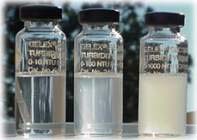
Turbidity is the cloudiness or haziness of a fluid caused by large numbers of individual particles that are generally invisible to the naked eye, similar to smoke in air. The measurement of turbidity is a key test of both water clarity and water quality.
Optics is the branch of physics which involves the behavior and properties of light, including its interactions with matter and the construction of instruments that use or detect it. Optics usually describes the behavior of visible, ultraviolet, and infrared light. Because light is an electromagnetic wave, other forms of electromagnetic radiation such as X-rays, microwaves, and radio waves exhibit similar properties.

In the field of optics, transparency is the physical property of allowing light to pass through the material without appreciable scattering of light. On a macroscopic scale, the photons can be said to follow Snell's law. Translucency allows light to pass through but does not necessarily follow Snell's law; the photons can be scattered at either of the two interfaces, or internally, where there is a change in the index of refraction. In other words, a translucent material is made up of components with different indices of refraction. A transparent material is made up of components with a uniform index of refraction. Transparent materials appear clear, with the overall appearance of one color, or any combination leading up to a brilliant spectrum of every color. The opposite property of translucency is opacity. Other categories of visual appearance, related to the perception of regular or diffuse reflection and transmission of light, have been organized under the concept of cesia in an order system with three variables, including transparency, translucency and opacity among the involved aspects.

Spectrophotometry is a branch of electromagnetic spectroscopy concerned with the quantitative measurement of the reflection or transmission properties of a material as a function of wavelength. Spectrophotometry uses photometers, known as spectrophotometers, that can measure the intensity of a light beam at different wavelengths. Although spectrophotometry is most commonly applied to ultraviolet, visible, and infrared radiation, modern spectrophotometers can interrogate wide swaths of the electromagnetic spectrum, including x-ray, ultraviolet, visible, infrared, and/or microwave wavelengths.
Absorbance is defined as "the logarithm of the ratio of incident to transmitted radiant power through a sample ". Alternatively, for samples which scatter light, absorbance may be defined as "the negative logarithm of one minus absorptance, as measured on a uniform sample". The term is used in many technical areas to quantify the results of an experimental measurement. While the term has its origin in quantifying the absorption of light, it is often entangled with quantification of light which is “lost” to a detector system through other mechanisms. What these uses of the term tend to have in common is that they refer to a logarithm of the ratio of a quantity of light incident on a sample or material to that which is detected after the light has interacted with the sample.
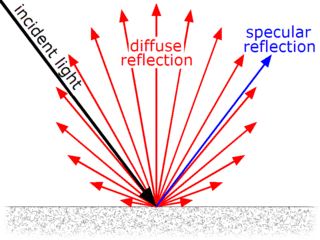
Diffuse reflection is the reflection of light or other waves or particles from a surface such that a ray incident on the surface is scattered at many angles rather than at just one angle as in the case of specular reflection. An ideal diffuse reflecting surface is said to exhibit Lambertian reflection, meaning that there is equal luminance when viewed from all directions lying in the half-space adjacent to the surface.

Retroreflective sheeting is flexible retroreflective material primarily used to increase the nighttime conspicuity of traffic signs, high-visibility clothing, and other items so they are safely and effectively visible in the light of an approaching driver's headlamps. They are also used as a material to increase the scanning range of barcodes in factory settings. The sheeting consists of retroreflective glass beads, microprisms, or encapsulated lenses sealed onto a fabric or plastic substrate. Many different colors and degrees of reflection intensity are provided by numerous manufacturers for various applications. As with any retroreflector, sheeting glows brightly when there is a small angle between the observer's eye and the light source directed toward the sheeting but appears nonreflective when viewed from other directions.
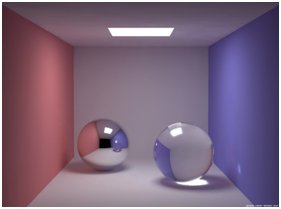
Gloss is an optical property which indicates how well a surface reflects light in a specular (mirror-like) direction. It is one of the important parameters that are used to describe the visual appearance of an object. Other categories of visual appearance related to the perception of regular or diffuse reflection and transmission of light have been organized under the concept of cesia in an order system with three variables, including gloss among the involved aspects. The factors that affect gloss are the refractive index of the material, the angle of incident light and the surface topography.

An optical fiber, or optical fibre, is a flexible glass or plastic fiber that can transmit light from one end to the other. Such fibers find wide usage in fiber-optic communications, where they permit transmission over longer distances and at higher bandwidths than electrical cables. Fibers are used instead of metal wires because signals travel along them with less loss and are immune to electromagnetic interference. Fibers are also used for illumination and imaging, and are often wrapped in bundles so they may be used to carry light into, or images out of confined spaces, as in the case of a fiberscope. Specially designed fibers are also used for a variety of other applications, such as fiber optic sensors and fiber lasers.

A refractometer is a laboratory or field device for the measurement of an index of refraction (refractometry). The index of refraction is calculated from the observed refraction angle using Snell's law. For mixtures, the index of refraction then allows the concentration to be determined using mixing rules such as the Gladstone–Dale relation and Lorentz–Lorenz equation.
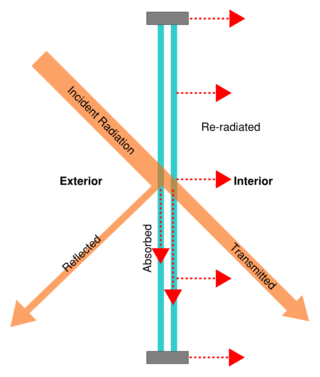
Solar gain is the increase in thermal energy of a space, object or structure as it absorbs incident solar radiation. The amount of solar gain a space experiences is a function of the total incident solar irradiance and of the ability of any intervening material to transmit or resist the radiation.

An integrating sphere is an optical component consisting of a hollow spherical cavity with its interior covered with a diffuse white reflective coating, with small holes for entrance and exit ports. Its relevant property is a uniform scattering or diffusing effect. Light rays incident on any point on the inner surface are, by multiple scattering reflections, distributed equally to all other points. The effects of the original direction of light are minimized. An integrating sphere may be thought of as a diffuser which preserves power but destroys spatial information. It is typically used with some light source and a detector for optical power measurement. A similar device is the focusing or Coblentz sphere, which differs in that it has a mirror-like (specular) inner surface rather than a diffuse inner surface.
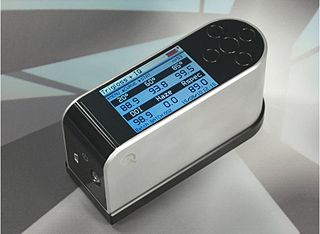
A glossmeter is an instrument which is used to measure specular reflection gloss of a surface. Gloss is determined by projecting a beam of light at a fixed intensity and angle onto a surface and measuring the amount of reflected light at an equal but opposite angle.
The visual appearance of objects is given by the way in which they reflect and transmit light. The color of objects is determined by the parts of the spectrum of light that are reflected or transmitted without being absorbed. Additional appearance attributes are based on the directional distribution of reflected (BRDF) or transmitted light (BTDF) described by attributes like glossy, shiny versus dull, matte, clear, turbid, distinct, etc. Since "visual appearance" is a general concept that includes also various other visual phenomena, such as color, visual texture, visual perception of shape, size, etc., the specific aspects related to how humans see different spatial distributions of light have been given the name cesia. It marks a difference with color, which could be defined as the sensation arising from different spectral compositions or distributions of light.
Picture framing glass usually refers to flat glass or acrylic ("plexi") used for framing artwork and for presenting art objects in a display box.
A haze meter measures the amount of light that is diffused or scattered when passing through a transparent material. Transparency is important because a material needs to be more or less see-through depending on its practical usage, e.g. a grocery bag needs the light to be more diffused so that less can be seen while food packaging film needs the light to be less diffused so that the contents can be seen clearly. For reasons such as these haze meters are necessary to determine which material is needed for which practical purpose.
Neutron microscopes use neutrons to create images by nuclear fission of lithium-6 using small-angle neutron scattering. Neutrons also have no electric charge, enabling them to penetrate substances to gain information about structure that is not accessible through other forms of microscopy. As of 2013, neutron microscopes offered four-fold magnification and 10-20 times better illumination than pinhole neutron cameras. The system increases the signal rate at least 50-fold.
There are two different types of haze that can occur in materials:











